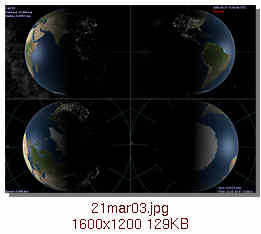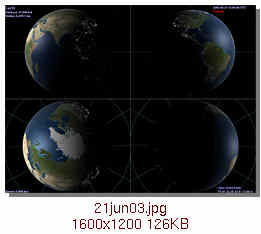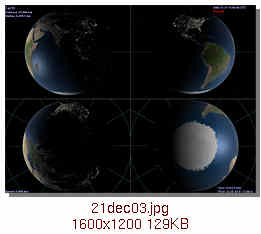In Celestia 1.3.1 pre 11,while Africa is in full sunshine,Europe is immersed in the darkness of the night.The same with South and North America,respectivily.I downloaded all the Earth files from Johns new site.
Look to my solarsys.ssc :
Texture "4kEarth.PNG"
NightTexture "4kEarthNight.PNG"
#SpecularTexture "4kEarthSpec.png"
Color [ 0.85 0.85 1.0 ]
SpecularColor [ 0.5 0.5 0.55 ]
SpecularPower 25.0
HazeColor [ 1 1 1 ]
HazeDensity 0.3
Radius 6378.140 # equatorial
# Oblateness 0.0034
# BumpMap "4kEarthBump.PNG"
# BumpHeight 4.5
Earth nightlights bug
Hello Daniel
I don't think this is a bug with Celestia or with Johns textures, it is actually what happens.
The Earth is tilted on it's axis at an angle of 23.5 degrees, so the night 'shadow' is not cast on the Earth in an exact straight line down a line of longitude, but diagonally at an angle I would guess of 23.5 degrees to the vertical.
Here's a link to a site with some nice little animations that should explain it better; http://vortex.plymouth.edu/sun.html
Also don't forget that most of South America is positioned at a longitude further east than North America. In general South America lies between -30' and -90' while North America lies between -60' and -165'
regards
TERRIER
I don't think this is a bug with Celestia or with Johns textures, it is actually what happens.
The Earth is tilted on it's axis at an angle of 23.5 degrees, so the night 'shadow' is not cast on the Earth in an exact straight line down a line of longitude, but diagonally at an angle I would guess of 23.5 degrees to the vertical.
Here's a link to a site with some nice little animations that should explain it better; http://vortex.plymouth.edu/sun.html
Also don't forget that most of South America is positioned at a longitude further east than North America. In general South America lies between -30' and -90' while North America lies between -60' and -165'
regards
TERRIER
1.6.0:AMDAth1.2GHz 1GbDDR266:Ge6200 256mbDDR250:WinXP-SP3:1280x1024x32FS:v196.21@AA4x:AF16x:IS=HQ:T.Buff=ON Earth16Kdds@15KkmArctic2000AD:FOV1:SPEC L5dds:NORM L5dxt5:CLOUD L5dds:
NIGHT L5dds:MOON L4dds:GALXY ON:MAG 15.2-SAP:TIME 1000x:RP=OGL2:10.3FPS
NIGHT L5dds:MOON L4dds:GALXY ON:MAG 15.2-SAP:TIME 1000x:RP=OGL2:10.3FPS
Nightlights bug
OK,but I have a great amount of Earth at night and very little at sunlight.That?s strange.While only South America and Africa is at day,all other parts of the world are at night.Besides that,even when the sun rises in a country,the "ghost" of the city lights continue to shining.This is very strange,indeed!
-
JackHiggins
- Posts: 1034
- Joined: 16.12.2002
- With us: 21 years 11 months
- Location: People's Republic Of Cork, Ireland
Usually (I find) that happens if you have one of the crappier rendering options turned on. Pressing Ctrl + V a few times, or maybe turning up ambient light Shift + } could solve some of the problems. Then again, the sea is fairly dark too...
Run time forward 6 months until the northern hemisphere summer, and see if russia & north america show up really dark too..?!
Run time forward 6 months until the northern hemisphere summer, and see if russia & north america show up really dark too..?!
I tried,but didn?t work very well.In a moment,it appears that everything was all right,but when I change ambient lighting,the sunny areas appeared with the "ghost" of the city lights.Independent of the level of ambient lighting or texture rendering,this lights doesn?t disappear,unless the Sun is directly overhead.A strange thing : Africa at sunlight,Europe at night,South America at sunlight again and North America again at night;everything at the same time,This is weird.I don?t know if the problem could be with the texture "EarthNight8k.dds" by Praesepe,I think.By the way,when I advance to July,North America and Russia was in shadow.Then I start to change the ambient lighting and the textures configs.Could I messed it up?
-
JackHiggins
- Posts: 1034
- Joined: 16.12.2002
- With us: 21 years 11 months
- Location: People's Republic Of Cork, Ireland
The problem with night lights showing up in the day time
used to exist in an older version of Celestia
But Chris did solve this problem a while ago
I'm just wondering if Daniel is using the new 131 pre11 .exe
but still has the older shaders installed
used to exist in an older version of Celestia
But Chris did solve this problem a while ago
I'm just wondering if Daniel is using the new 131 pre11 .exe
but still has the older shaders installed
CPU- Intel Pentium Core 2 Quad ,2.40GHz
RAM- 2Gb 1066MHz DDR2
Motherboard- Gigabyte P35 DQ6
Video Card- Nvidia GeForce 8800 GTS + 640Mb
Hard Drives- 2 SATA Raptor 10000rpm 150GB
OS- Windows Vista Home Premium 32
RAM- 2Gb 1066MHz DDR2
Motherboard- Gigabyte P35 DQ6
Video Card- Nvidia GeForce 8800 GTS + 640Mb
Hard Drives- 2 SATA Raptor 10000rpm 150GB
OS- Windows Vista Home Premium 32
-
JackHiggins
- Posts: 1034
- Joined: 16.12.2002
- With us: 21 years 11 months
- Location: People's Republic Of Cork, Ireland
I tried,but didn?t work.Actually,the city lights only disappear when the sun shines exactly in that position.For example,all Africa became full iluminated by the Sun and Europe is still at dark,with city lights on.The strangiest thing is that even when is day in some part of the northern hemisphere,the city lights shine dimly,like a "ghost".I realize that the biggest problem is with the northern hemisphere.And earlier version had this problem too(like Celestia 1.3.0)
Daniel,
Have you taken the seasons and the tilt of the Earth's axis into account? We are approaching the winter solstice now in the northern hemisphere.
Below are what I see using Celestia v1.3.1pre11 at Noon GMT of days near the spring equinox and the summer and winter solstices. (I didn't include the fall equinox because it's identical to the spring equinox.)
Ambient light is set to None.
Only the textures included with Celestia were used for these pictures. No addons are included.
Do you see something different?



(as usual, each thumbnail links to a larger image)
The four viewpoints in each image are
lat 0 long -90 | lat 0, long 90
lat 89.99 long -90 | lat -89.99, long 90
Have you taken the seasons and the tilt of the Earth's axis into account? We are approaching the winter solstice now in the northern hemisphere.
Below are what I see using Celestia v1.3.1pre11 at Noon GMT of days near the spring equinox and the summer and winter solstices. (I didn't include the fall equinox because it's identical to the spring equinox.)
Ambient light is set to None.
Only the textures included with Celestia were used for these pictures. No addons are included.
Do you see something different?



(as usual, each thumbnail links to a larger image)
The four viewpoints in each image are
lat 0 long -90 | lat 0, long 90
lat 89.99 long -90 | lat -89.99, long 90
Selden
-
Guest
hi, first post for me here.
I'm live western europe, it's nearly 11 o'clock in the morning here (local time). When i look outside i see the city lights are out and it's definately daytime. In Celestia and in reality the sun is some 15 to 20 degrees over the horizon. (celestia still showing sunrise colors at the horizon but that's another matter).
When i look at western europe in Celestia (current local time), all of europe is in twilight with nightlights showing. Even the coast of N Africa shows nightlights.
When i let time progress in Celestia, it remains twilight-like and nightlights remain on all throughout daytime in central-western europe (vicinity of England). The same is true in similar conditions in other parts of the world. It seems as though in Celestia the lightlevel for winter-daytime is to low and/or nightlights just remain on for to long (or fade out to slowly). Maybe it's not a bug, but it seems to me it does not correspond to reality.
I compared Selden's equinox/solstice screenshots with what my celestia installation shows: no difference.
How does reality compare to what celestia shows wrt nightlights and lightlevels where you live?
I'm live western europe, it's nearly 11 o'clock in the morning here (local time). When i look outside i see the city lights are out and it's definately daytime. In Celestia and in reality the sun is some 15 to 20 degrees over the horizon. (celestia still showing sunrise colors at the horizon but that's another matter).
When i look at western europe in Celestia (current local time), all of europe is in twilight with nightlights showing. Even the coast of N Africa shows nightlights.
When i let time progress in Celestia, it remains twilight-like and nightlights remain on all throughout daytime in central-western europe (vicinity of England). The same is true in similar conditions in other parts of the world. It seems as though in Celestia the lightlevel for winter-daytime is to low and/or nightlights just remain on for to long (or fade out to slowly). Maybe it's not a bug, but it seems to me it does not correspond to reality.
I compared Selden's equinox/solstice screenshots with what my celestia installation shows: no difference.
How does reality compare to what celestia shows wrt nightlights and lightlevels where you live?
-
JackHiggins
- Posts: 1034
- Joined: 16.12.2002
- With us: 21 years 11 months
- Location: People's Republic Of Cork, Ireland
This is because in celestia planets use a simple method for working out what part of a planet should be bright or dark. (No, I don't know how it works- it's simple to the developers!  ) This method shows the terminator (the line between day and night) as a gradual transition, whereas really it should be more defined. A good example is on the moon. Celestia shows a gradual transition from bright to dark, where in real life it's a sharply defined line (as visible from the earth).
) This method shows the terminator (the line between day and night) as a gradual transition, whereas really it should be more defined. A good example is on the moon. Celestia shows a gradual transition from bright to dark, where in real life it's a sharply defined line (as visible from the earth).
Chris mentioned a while back that he would implement a more realistic system for showing the terminator a while back- a "lambertian" model, I think...? (Or is that the current system?) I don't know if anything has happened with this yet though.
Chris mentioned a while back that he would implement a more realistic system for showing the terminator a while back- a "lambertian" model, I think...? (Or is that the current system?) I don't know if anything has happened with this yet though.
